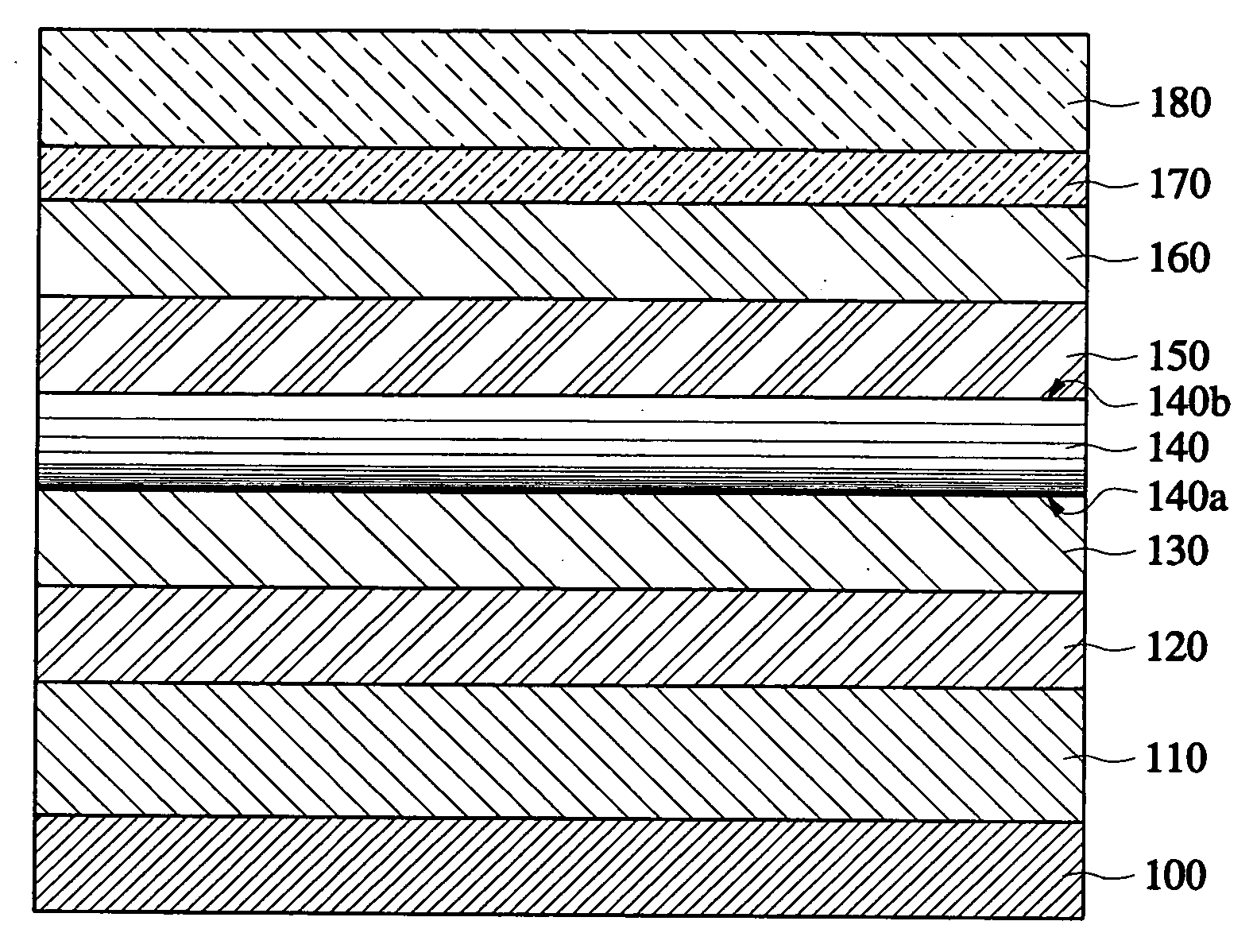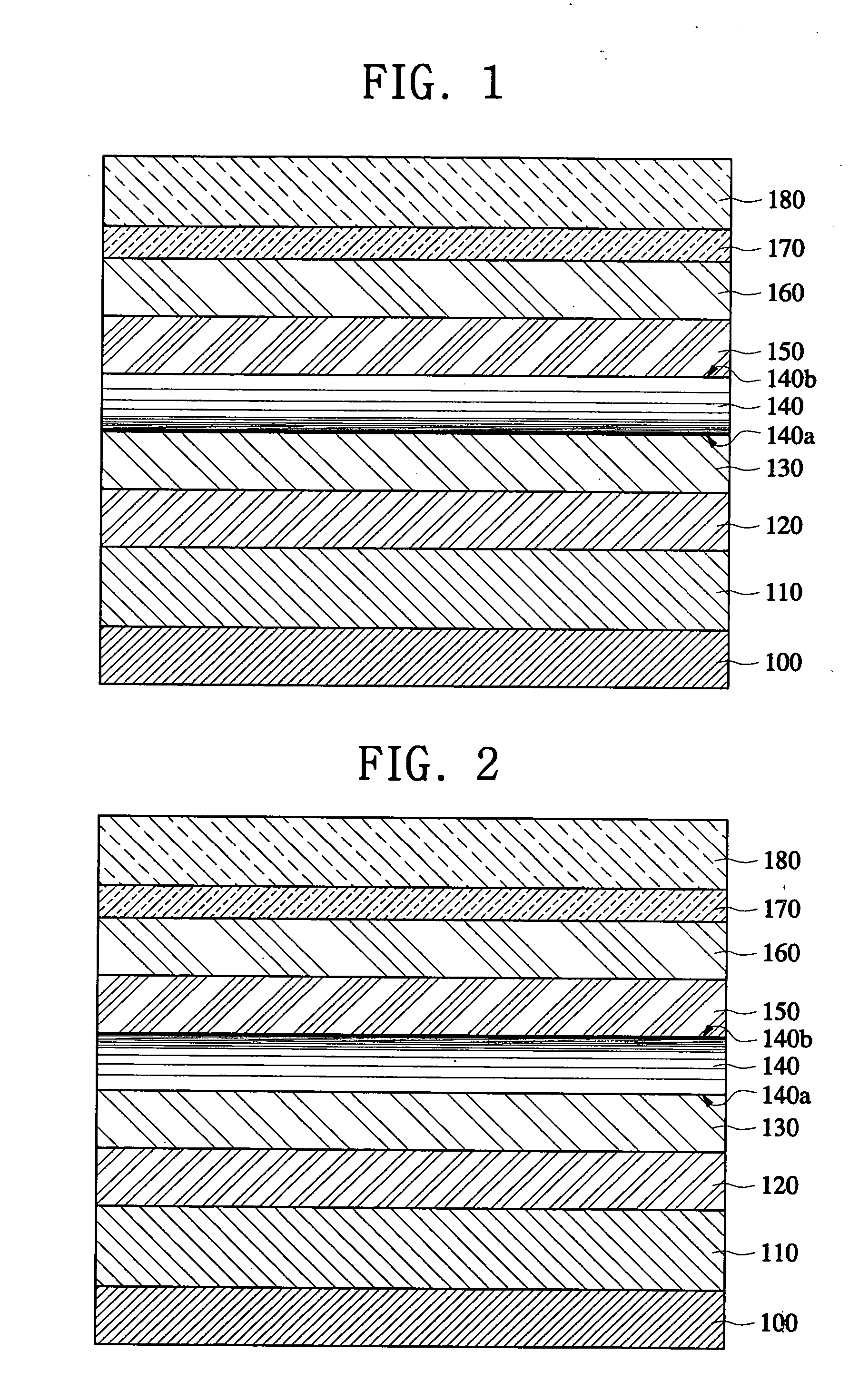Organic lights-emitting device with doped emission layer
- Summary
- Abstract
- Description
- Claims
- Application Information
AI Technical Summary
Benefits of technology
Problems solved by technology
Method used
Image
Examples
first example
Ir(ppy)3 10 wt. %-7 wt. %-4 wt. % graded EML
[0035] An ITO substrate patterned with a width of 80 μm was subject to an ultrasonic cleaning and UV-O3 treatment, and a small-molecule type material of IDEMITZ 406 (available from IDEMITZ Co. and with a 5.1 eV of HOMO (Highest Occupied Molecular Orbital)) was then vacuum deposited with a thickness of 600 Å to form an HIL. A non-polymer material of IDEMITZ 320 (available from IDEMITZ Co. and with a 5.4 eV of HOMO) was then vacuum deposited with a thickness of 300 Å to form a HTL. A host material of CBP and Ir(ppy)3 was codeposited with a thickness of 80 Å on the HTL so as to have the concentration of Ir(ppy)3, which is a green phosphorus dopant, be 10% by weight, and CBP and Ir(ppy)3 was codeposited with a thickness of 80 Å so as to have the concentration of Ir(ppy)3 be 7% by weight, and CBP and Ir(ppy)3 was codeposited with a thickness of 80 Å so as to have the concentration of Ir(ppy)3 be 4% by weight, so that the EML having a total thi...
second example
RD61 4%-8%-12% graded EML
[0043] An ITO substrate patterned with a width of 80 μm was subject to an ultrasonic cleaning and UV-O3 treatment, and non-polymer material of IDEMITZ 406 (available from IDEMITZ Co. and with a HOMO of 5.1 eV) was vacuum deposited with a thickness of 600 Å to form an HIL. A non-polymer material of IDEMITZ 320 (available from IDEMITZ Co. and with a 5.4 eV of HOMO) was then vacuum deposited with a thickness of 300 Å to form an HTL. A host material of CBP and RD61 (Iridium (III)bis(1-phenyl(quinolinato-N,C2′))acetylacetonate, available from UDC Co.) was codeposited with a thickness of 100 Å on the HTL so as to have the concentration of RD61, which is a red phosphorus dopant, be 4% by weight, and CBP and RD61 was codeposited with a thickness of 100 Å so as to have the concentration of RD61 be 8% by weight. CBP and RD61 was codeposited with a thickness of 100 Å so as to have the concentration of RD61 be 12% by weight, so that a EML having a total thickness of 30...
PUM
| Property | Measurement | Unit |
|---|---|---|
| Percent by mass | aaaaa | aaaaa |
| Percent by mass | aaaaa | aaaaa |
| Thickness | aaaaa | aaaaa |
Abstract
Description
Claims
Application Information
 Login to View More
Login to View More - R&D
- Intellectual Property
- Life Sciences
- Materials
- Tech Scout
- Unparalleled Data Quality
- Higher Quality Content
- 60% Fewer Hallucinations
Browse by: Latest US Patents, China's latest patents, Technical Efficacy Thesaurus, Application Domain, Technology Topic, Popular Technical Reports.
© 2025 PatSnap. All rights reserved.Legal|Privacy policy|Modern Slavery Act Transparency Statement|Sitemap|About US| Contact US: help@patsnap.com



